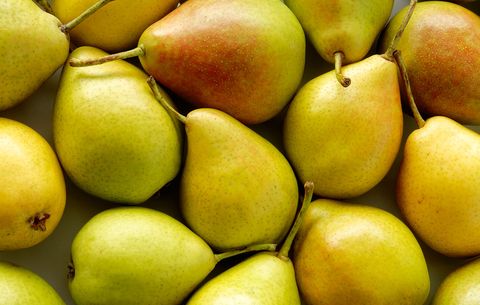12 Foods That Have More Fiber Than A Fiber Bar

Yes, everyone wants to feel full for hours after they eat lunch and never be bloated again. But like, how?!? Well, there’s one solution that’s not exactly sexy (your grandma probably swears by it), but it works: fiber, baby.
Okay, yes, so fiber bars can be kind of nasty. But you can (and should) get this stuff from real food, too. Fiber helps keep your bowels regular, naturally lowers your LDL cholesterol, and, yes, makes you feel fuller for longer. “High-fiber diets have also been linked to lower rates of colon cancer, and most of us aren’t getting nearly enough,” says Alex Caspero, R.D.
That said, too much fiber can shock your system, causing bloating and diarrhea (fun!). “If you’re only eating 10 grams now, please don’t start eating 50,” says Caspero. She recommends adding in five grams at a time every few days over the course of a week until you hit about 30 grams per day—the sweet spot for most adult women.
And don’t forget to drink at least eight glasses of water a day to keep all that bulk moving through your GI tract (otherwise you’ll get gassy and bloated).
Not sure where to start? Here are 12 high-fiber foods that have at least the five grams of fiber you’ll find in a typical fiber bar to help you hit your goal:
Artichoke

Getty Images
Fiber: 7 grams per medium uncooked artichoke
Artichokes are a great source of fiber—but a pain to prepare. To make life easier, Caspero suggests adding frozen or canned artichokes to salads and frittatas. Or toss into whole-wheat pasta with sautéed sun dried tomatoes, parsley, chicken, and a sprinkle of feta for a fiber-rich Mediterranean meal.
Lima beans

Getty Images
Fiber: 12 grams per 1-cup serving
Frozen or canned is your best option to get all the fiber in lima beans; pair with corn to make a savory succotash. “Corn gets a bad rap, but it’s technically a veggie and it’s relatively high-fiber,” Caspero says. Or puree lima beans with lemon juice, olive oil, salt, and pepper to make a “hummus” for veggie dip or a spread on sandwiches.
Lentils

Getty Images
Fiber: 16 grams per 1-cup cooked serving
You’ll get TONS of fiber and protein in every cup of this vegetarian staple. Buy a bag for a dollar at the grocery store and forget the soaking; just drop in simmering water and they’re ready in 30 minutes. Caspero recommends using lentils as a filling for tacos or burritos, or making a “lentil loaf” (like meatloaf…but with lentils).
Black beans

Getty Images
Fiber: 17 grams per 1-cup serving
Caspero suggests lightly mashing black beans and adding to sandwiches, pairing with sweet potatoes and a sprinkling of cheese, adding to soups and salads, or wrapping in a whole-wheat tortilla with turkey and hummus.
Whole-wheat pasta

Getty Images
Fiber: 6 grams per 1 cup of cooked pasta
Pasta is a surprisingly high-fiber food, if you do it right. Take your whole-wheat pasta and toss with about two cups of cooked mixed veggies, plus tomato sauce or olive oil and lemon, and you’ll have a fiber-rich meal.
Get even more veggies by making zoodles—try these seven fun ideas:
Raspberries

Getty Images
Fiber: 8 grams per 1-cup serving
The season for raspberries—June to August—is fairly short, and they’re pricey otherwise. But you can enjoy fiber-rich raspberries out of season if you buy frozen, then add to smoothies or fiber-rich oatmeal.
Chickpeas

Getty Images
Fiber: 11 grams per 1-cup serving
“I call chickpeas my chicken,” says Caspero, since she swaps the high-fiber, vegetarian protein anywhere she’d otherwise use chicken. Because they’re pretty bland, they marry well in lots of different dishes. Toss them in a blender with mayo, celery, and carrots to make a take on chicken salad that’s high in fiber and protein.
Barley

Getty Images
Fiber: 6 grams per 1-cup serving (cooked)
You might associate barley with soups, but it works just as well anywhere you’d use rice. Buy a pack of 10-minute barley at Trader Joe’s and make one big batch that you can keep in the fridge all week. Mix with roasted veggies (like onions, broccoli, and red peppers to get an extra fiber kick), a serving of chicken, and dressing for a hearty lunch or dinner.
Pears

Getty Images
Fiber: 6 grams fiber per medium pear
When you think of fiber-rich fruits, you probably think of apples, but you’ll actually get a lot of it in pears, too. Pair it with almond butter for a snack or with almost any savory food, like cheese in a salad.
Avocados

Getty Images
Fiber: 7 grams per half avocado
Yet another reason to love brunch’s favorite food! Slather it on toast, dice, and toss with your favorite salad, or just slice and put on top of your sandwich to boost your meal’s healthy fat and fiber content.
Blackberries

Getty Images
Fiber: 8 grams per 1-cup serving
Like raspberries, blackberries are a high-fiber food that you should have in your repertoire. Fresh or frozen, you can eat these babies in yogurt, as part of a fruit salad, or just pop ’em raw.
Peanuts

Getty Images
Fiber: 6 grams per 1/2-cup serving
Peanuts have a surprisingly-high amount of fiber for such a small, ordinary nut. As if you didn’t have enough reason to love peanut butter already. Toss the nuts into a stir fry or salad, or just eat some PB out of the jar.
Source: Read Full Article


